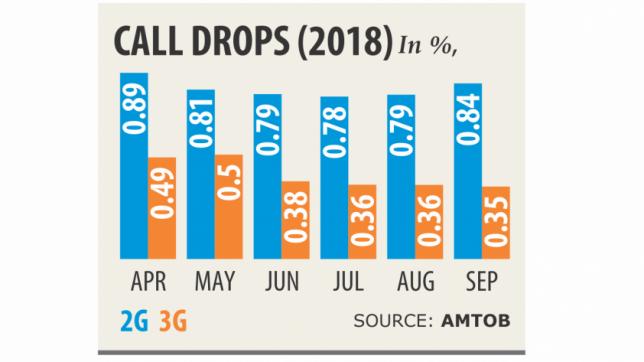Call drop lower than developed world's

China Mobile phone operators yesterday said the industry average for call drops is about 0.8 percent, which is lower than the average of the developed world and within the ceiling of the telecom regulator.
According to the Bangladesh Telecommunication Regulatory Commission (BTRC), a 2 percent call drop is acceptable while the International Telecommunication Union's tolerable level was 3 percent.
For India, the acceptable call drop was 2 percent while for Malaysia it was 5 percent, said mobile operators at a working session at the La Vinci hotel in Dhaka.
There is no such ceiling for countries like the United Kingdom, France, Germany and Australia.
In the session “Quality of Service: Expectation and Reality” organised by the Association of Mobile Telecom Operators of Bangladesh (AMTOB), operators said fibre optic cable cut, spectrum shortage, shortage of spots for establishing telecommunications sites and densely populated city areas were the main causes for the call drops.
“In the city, there are dozens of restricted areas where we cannot set up our networks and frequent use of jammers also causes call drops,” said Shahed Alam, executive vice-president and head of regulatory affairs at Robi, the second largest operator.
The Defense Officers Housing Schemes in the capital do not allow setting up of mobile networks inside their areas alongside the authorities of Bashundhara residential area, Banasree, officers club and Ramna area, he said.
Mobile operators also cannot set up networks from Banani to Airport for some unresolved issues and from Bijoy Sarani to Jahangir Gate there are huge jammers similar to those at the old central jail, said top executives of a number of operators.
Some mosques also use jammers, they said.
“The same happens in the Chittagong port, DOHS and airport areas,” said Alam.
Cell phone jammer is an electronic device that blocks transmission of signals between a mobile phone and a base station. By using the same frequency as a mobile handset, it creates strong interference for communication between the caller and receiver. Operators said when a call is generated by a customer it passes through a number of channels such as nationwide transmission networks, internet connections, internet exchanges and in some cases international gateways, before reaching a receiver. The operators have nothing to do if something goes wrong at any channel, the top executives said.
Two weeks ago, the BTRC published a report showing that there were 222.15 crore call drops between September last year and September this year and the operators were supposed to give back 69.38 crore minutes to the affected subscribers for free as compensation.
The report said Grameenphone had 103 crore call drops. Robi and Banglalink had 76.18 crore and 36.54 crore call drops respectively during the time.
Hossain Sadat, acting chief corporate affairs officer of the market leader, said during the period, GP handled 9,000 crore calls.
“If we convert it to percentage, it will be about 1 percent. But when you say 103 crore, it seems to be a huge amount,” Sadat added.
He said fibre optic cable cut was their main challenge right now. Currently they are experiencing 50 fibre cuts every month, which was about 20 just one year before, he said.
In the current network running process, optical fibre cable is the main component for the mobile operators to run their operation, the top officials said.
Operators also pointed out a lack of optical fibres as another bottleneck for them as they were not allowed to lay them on their own.
“In about 90 percent cases we do not get optical fibre cable connection in the places we want,” said Taimur Rahman, chief corporate and regulatory affairs officer at Banglalink.
He also pointed out power shortage and complex network running process and low quality of handsets for the call drops and poor service quality.
Operators said there are 185 megahertz of spectrum in the country and mobile operators are currently using about 130 MHz. They demanded allocation of the unused spectrum at a minimum cost to help them improve service quality.
The operators said the service quality can be improved by more than 60 percent if the government resolves some of the challenges which are not in their control.
Of the total drops, mobile phone operators gave back only a third of the minutes payable to users, the report said.
The call drop issue was brought to attention when Commerce Minister Tofail Ahmed raised it in parliament on October 21 and expressed dissatisfaction over the call drops related to Grameenphone.
Saifur Rahman Khan, a deputy general manager of state-owned Teletalk, and Abdullah Al Mamun, manager for communication and research of the AMTOB, also attended the event.
